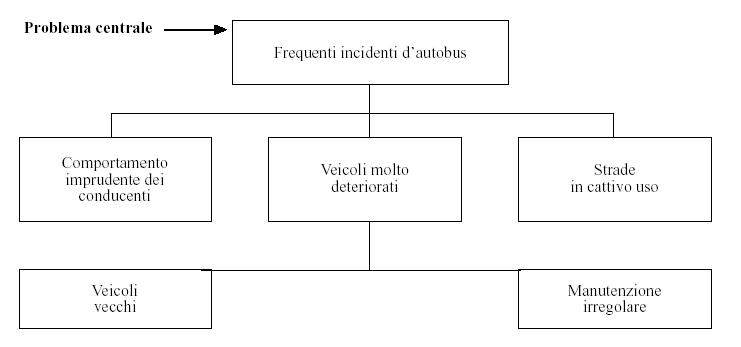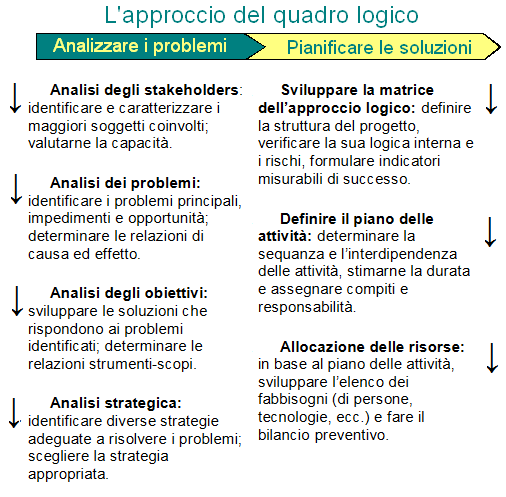
The problem tree
Identifying phase of programme cycle management
See also Exploring the problem/s; : The factors causing poverty and suffering : Objective tree ; The logical framework
The activities that project teams carry out must produce outputs that will empower project beneficiaries to better interact with their communities and utilise project deliverables to achieve the project outcomes These outcomes will enable the communities to tackle the problems identified and produce changes in the factors generating these problems, thereby contributing to the achievement of the project objectives To make the project successful, it is necessary that project teams understand the requirements, needs and problems of the beneficiaries and that the beneficiaries understand the requirements, needs and problems of the communities. If the project team has correctly understood the needs and problems of the target beneficiaries, they will be able to utilise the outputs to empower beneficiaries, i.e. move from outputs to outcomes If the project beneficiaries have correctly understood the needs and problems of the communities, they will be able to empower communities, i.e. move from outcomes to impact Without active contribution of beneficiariers, project ouputs will not be utilised to achieve project outcomes Without active contribution of commmunities, beneficiariers will not be able to utilise outcomes to achieve impact.
The problem tree moves top downwards, identifying first the major problem, then the factors that determine these problems and then the causes of these factors.
The objective tree moves bottom upwards, first identifying the outputs that would directly address the causes of the factors and then identifying the specific objectives that directly address the causes of these factors.

|
Una volta definito l’albero dei problemi si elabora in modo speculare l’albero degli obiettivi traducendo in positivo il contenuto delle caselle dell’albero dei problemi. |

|
In questo diagramma si osservano i diversi livelli progettuali che vengono poi inseriti nel quadro logico. E' interessante soffermarsi su un punto. Se si analizza “l’obiettivo centrale” costituito da tre cause: una legata agli autisti, una legata ai veicoli ed una legata alle strade. Una possibile strategia progettuale, potrebbe trattare il problema dei veicoli (zona grigia). Il diagramma ci dice però che se non verranno trattate le problematiche degli autisti e delle strade, il problema non verrà risolto, ovverosia l’obiettivo della riduzione della frequenza di incidenti non verrà raggiunto. Per la precisione, in termini generali ed andando oltre il caso in analisi, si può dire che un progetto raggiungerà l’obiettivo centrale in maggior o minor grado in funzione di quanto, questa componente trattata dal progetto, “partecipa ad originare l’effetto”. |

|
n questo diagramma si osservano i diversi livelli progettuali che vengono poi inseriti nel quadro logico. E' interessante soffermarsi su un punto. Se si analizza “l’obiettivo centrale” costituito da tre cause: una legata agli autisti, una legata ai veicoli ed una legata alle strade. Una possibile strategia progettuale, potrebbe trattare il problema dei veicoli (zona grigia). Il diagramma ci dice però che se non verranno trattate le problematiche degli autisti e delle strade, il problema non verrà risolto, ovverosia l’obiettivo della riduzione della frequenza di incidenti non verrà raggiunto. Per la precisione, in termini generali ed andando oltre il caso in analisi, si può dire che un progetto raggiungerà l’obiettivo centrale in maggior o minor grado in funzione di quanto, questa componente trattata dal progetto, “partecipa ad originare l’effetto”. |
|
Tabella per la preparazione del quadro logico del progetto
Se il quadro logico è bene articolato, un lettore esterno dovrebbe facilmente essere in grado di capire:
Questo pertanto permetterà ad un valutatore di compiere la sua valutazione in modo appropriato e condiviso.
Quadro un progetto non ha un quadro logico, sarà sempre buona prassi del valutatore ricostruirlo sulla base dei documenti progettuali. Se il valutatore non è in grado di ricostruire un quadro logico coerente, significa generalmente che il progetto ha delle incongruenze o delle incompletezze.
|
|
Il Logical Framework, secondo la definizione del Nucleo di Valutazione delDevelopment Assistance Committee (DAC-OCSE), è uno strumento di gestione che consiste in “un insieme di concetti interconnessi, utilizzati in maniera dinamica per l’elaborazione, il monitoraggio e la valutazione di un Programma o di un progetto”. Il Logical Framework permette di riassumere, in termini oggettivi, gli elementi di un programma (mezzi, risultati, scopo, obiettivo), i rapporti di causalità tra gli aspetti operativi (risorse, attività, risultati) per facilitarne la pianificazione, la realizzazione e la valutazione. Secondo le linee metodologiche adottate dalla Commissione Europea per la Sorveglianza e Valutazione degli interventi Strutturali, l’applicazione di questo schema logico permette di evidenziare le relazioni e la coerenza tra i diversi livelli d’intervento e la necessaria articolazione “a cascata” degli obiettivi-risultati-interventi per i Programmi e Progetti. |
2. Do the different objectives set reflect real problems? If the initial
analysis has not been conducted
properly, it does not reflect the true nature or the core of the problems.
For example in a project
aiming to improve prison conditions the initial analysis might have revealed
as main problem the
lack of proper infrastructure. If the true problem stems more from the
negative attitudes of the prison
personnel, the mere acquisition of new equipment would not improve the
prisoners’ conditions as
planned.
3. How realistic is the Project Purpose? Many project designers set
unrealistic Project Purposes. Such
projects are not likely to have the planned impact.
4. How well have the Objectively Verifiable Indicators been chosen and do
they really measure the
objectives at each level? This question aims to analyse how concrete the set
objectives are.
5. Is it possible to measure the Objectively Verifiable Indicators, i.e.
have the sources of verification
been clearly defined. This question allows understanding if it will be
possible to measure the
project’s impact. In some cases, the analysis of impact is difficult either
because the Indicators are
poorly defined or the Sources of Verification are not available.
6. How well have the Assumptions been identified? Many projects fail because
of external factors, e.g.
a sudden change of government policy in the beneficiary country. A careful
analysis of Assumptions
in the planning stage of a project allows adapting the proposed operation to
its environment. When
analysed, some assumptions can turn out to be so-called “killer
assumptions”, meaning that if they
are not realised, the project should not take place in the first place. In
the Logframe, these are written
down as Pre-conditions.
7. Is the project constructed on a sufficiently detailed baseline data on
its target groups? This is a key
question as to the capacity to analyse the project’s impact and can only
partially be addressed ex post
by using secondary sources or memory-based information.